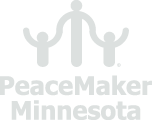Peace Guides bring “Listening Ear” to Schools
By Pam Schmid
Whether they call her “Miss Leah,” “Miss Young” or “Hey You, Peace Lady!”, elementary students at Kaposia Education Center in South St. Paul know Leah Young will lend an ear when they are struggling with a problem or conflict.
“They know they can come to me,” says Young, one of five Twin Cities-area Peace Guides employed by PeaceMaker Minnesota this year. “You can’t always solve their problems, but a lot of times, just being listened to can change the mood. You can walk through the muck and get to more solid ground.”
Young continues a legacy of peacemaking in South St. Paul schools that stretches back nearly three decades, with roots in restorative justice practices that have promoted empathy and helped reduce fights, bullying and suspensions.
John Laliberte, PeaceMaker Minnesota’s board chair, can vouch for that. Soon after he was hired as Kaposia’s assistant principal in 1994, South St. Paul schools received a grant from the state Department of Education to underwrite training and staffing of three full-time peace guides.
Under the new disciplinary model, students who previously had been suspended or given detention were brought into restorative circles with those they had hurt.
“The number of behavior referrals kept going down,” recalls Stacy Elliott, Kaposia’s original Peace Guide—then known as a “restorative justice planner”—who now teachers second grade there. “I was able to go into all the classrooms and teach people how to do a circle, how to respect and listen to each other. All day long, I could pull kids and do circles.”
By the time Laliberte became Kaposia’s head principal in 1998, the grant had run its course, but he wanted to figure out how to keep the circles going. He knew that conflicts primarily happened on the playground and in the lunchroom. “What if we brought a person to help resolve those issues?” he wondered.
Enter Jodelle Ista, a former South St. Paul city council member who became interested in restorative justice after a friend’s house was vandalized by youth in the neighborhood. The neighbor used the process to promote healing and to restore the relationships that had been damaged. In the early 2000s, Ista helped to start the South St. Paul Restorative Justice Council with the neighbor and others, and became a Peace Guide at Kaposia Education Center.
“Jodelle was an energetic, listening type of grandma,” Laliberte said. “We created a room space for her to work with the kids, and it was perfect.”
By the time Laliberte retired in 2010, behavior referrals had dropped from 1,900 per year in 1994 to around 350 per year, he said.
Ista became president of the South St. Paul Restorative Justice Council around 2009. With her leadership, the Council helped PeaceMaker Minnesota raise contributions so that the schools in South St. Paul could pay the Council to employ Peace Guides at Kaposia and Lincoln Center Elementary. That three-way partnership continued through 2017.
In 2020, after a three-year hiatus, PeaceMaker Minnesota began to explore the possibility of returning Peace Guides to South St. Paul schools. Then the COVID-19 pandemic hit, nixing those plans. Instead, the organization pivoted to piloting its Peace Guide service at a Catholic school in Minneapolis that remained open during the pandemic.
PeaceMaker hired Young in the fall of 2021, finally returning a Peace Guide to South St. Paul. Young, a former teacher and a journalist who has covered education issues, spends ten hours per week on the playground and in the lunchroom at Kaposia, helping kids talk through struggles.
“There’s something really nourishing about watching somebody heal and improve and solve a problem,” Young says. “It’s kind of an honor to witness and be part of that.”
PeaceMaker Minnesota’s Peace Guides include educators, an early childhood specialist, a care provider and a longtime volunteer for the Conflict Resolution Center. Guides receive training in Collaborative Problem Solving (CPS), an evidence-based approach to dealing with challenging behaviors.
“It (CPS) equips the guides with another tool to be able to use to be able to solve conflicts,” says Hayla Drake, who manages the Peace Guide program for PeaceMaker Minnesota.
According to a newly released survey, 89% of teachers surveyed at the six schools with Peace Guides reported that most of their students receiving Peace Guide services have improved their behavior; the same percentage reported that a Peace Guide has helped to improve the overall learning environment for students.
While CPS is a new approach, the reignited Peace Guide service builds on what came before. Drake consulted with Elliott and Ista before reinstituting the service. “It was really cool to get the background and to hear what that service was like,” she says.
Ista passed away in January at age 87. In her memory, 18 people contributed $1,120 to PeaceMaker’s endowment fun for South St. Paul to carry on the work she was so instrumental in developing.
Young has also sought the advice of her predecessors, asking Elliott about resuming a peace club similar to one she had launched years ago at Kaposia.
“I was excited and happy,” Elliott says, “because there are definitely students who would love to be part of it and benefit from it. And they can do things to help all of us.”
Pam Schmid is a current board member of PeaceMaker Minnesota.


